PM2.5 Characteristics in Qingdao and across Coastal Cities in China
Abstract
:1. Introduction
2. Methodology
2.1. Sampling and Chemical Analysis
2.1.1. Study Location
2.1.2. Sampling
2.1.3. Water-Soluble Ions
2.1.4. Organic Carbon (OC) and Elemental Carbon (EC)
2.1.5. Inorganic Elements
2.2. Data Analysis Methods
2.2.1. Enrichment Factor
2.2.2. Chemical Mass Closure
2.2.3. Positive Matrix Factorization (PMF) Model
2.3. The PM2.5 Characteristics across Coastal Cities in China
3. Results and Discussions
3.1. PM2.5 Concentrations in Qingdao
3.2. Chemical Species
3.2.1. Water-Soluble Ions
Sulfate, Nitrate, and Ammonium
Formic, Acetic, and Oxalic Acids
Cl− and Cl-Depletion
3.2.2. Carbonaceous Species
3.2.3. Elemental Components
Elemental Concentrations
The EFs of Elements
3.2.4. Mass Closure
3.2.5. Source Apportionment
3.3. The PM2.5 Characteristics across Coastal Cities in China
3.3.1. Seasonality of Species in PM2.5 across Coastal Cities
3.3.2. Cl-Depletion
4. Conclusions
Supplementary Materials
Acknowledgments
Author Contributions
Conflicts of Interest
References
- Zhang, X.Y.; Wang, Y.Q.; Niu, T.; Zhang, X.C.; Gong, S.L.; Zhang, Y.M.; Sun, J.Y. Atmospheric aerosol compositions in China: Spatial/temporal variability, chemical signature, regional haze distribution and comparisons with global aerosols. Atmos. Chem. Phys. 2012, 12, 779–799. [Google Scholar] [CrossRef]
- Tiwari, S.; Srivastava, A.K.; Singh, A.K.; Singh, S. Identification of aerosol types over Indo-Gangetic Basin: Implications to optical properties and associated radiative forcing. Environ. Sci. Pollut. Res. 2015, 22, 12246–12260. [Google Scholar] [CrossRef] [PubMed]
- Lipfert, F.W. An assessment of air pollution exposure information for health studies. Atmosphere 2015, 6, 1736–1752. [Google Scholar] [CrossRef]
- He, K.; Yang, F.; Ma, Y.; Zhang, Q.; Yao, X.; Chan, C.K.; Cadle, S.; Chan, T.; Mulawa, P. The characteristics of PM2.5 in Beijing, China. Atmos. Environ. 2001, 35, 4959–4970. [Google Scholar] [CrossRef]
- Hu, M.; He, L.Y.; Zhang, Y.H.; Wang, M.; Kim, Y.P.; Moon, K.C. Seasonal variation of ionic species in fine particles at Qingdao, China. Atmos. Environ. 2002, 36, 5853–5859. [Google Scholar] [CrossRef]
- Li, X.D.; Yang, Z.; Fu, P.; Yu, J.; Lang, Y.C.; Liu, D.; Ono, K.; Kawamura, K. High abundances of dicarboxylic acids, oxocarboxylic acids, and α-dicarbonyls in fine aerosols (PM2.5) in Chengdu, China during wintertime haze pollution. Environ. Sci. Pollut. Res. 2015, 22, 12902–12918. [Google Scholar] [CrossRef] [PubMed]
- Wang, W.; Wang, S.; Xu, J.; Zhou, R.; Shi, C.; Zhou, B. Gas-phase ammonia and PM2.5 ammonium in a busy traffic area of Nanjing, China. Environ. Sci. Pollut. Res. 2016, 23, 1691–1702. [Google Scholar] [CrossRef] [PubMed]
- Ye, B.; Ji, X.; Yang, H.; Yao, X.; Chan, C.K.; Cadle, S.H.; Chan, T.; Mulawa, P.A. Concentration and chemical composition of PM2.5 in Shanghai for a 1-year period. Atmos. Environ. 2003, 37, 499–510. [Google Scholar] [CrossRef]
- Yang, L.; Zhou, X.; Wang, Z.; Zhou, Y.; Cheng, S.; Xu, P.; Gao, X.; Nie, W.; Wang, X.; Wang, W. Airborne fine particulate pollution in Jinan, China: Concentrations, chemical compositions and influence on visibility impairment. Atmos. Environ. 2012, 55, 506–514. [Google Scholar] [CrossRef]
- Zhou, X.; Cao, Z.; Ma, Y.; Wang, L.; Wu, R.; Wang, W. Concentrations, correlations and chemical species of PM2.5/PM10 based on published data in China: Potential implications for the revised particulate standard. Chemosphere 2016, 144, 518–526. [Google Scholar] [CrossRef] [PubMed]
- Lai, S.C.; Zou, S.C.; Cao, J.J.; Lee, S.C.; Ho, K.F. Characterizing ionic species in PM2.5 and PM10 in four pearl river delta cities, south China. J. Environ. Sci. 2007, 19, 939–947. [Google Scholar] [CrossRef]
- Nie, W.; Wang, T.; Wang, W.; Wei, X.; Liu, Q. Atmospheric concentrations of particulate sulfate and nitrate in Hong Kong during 1995–2008: Impact of local emission and super-regional transport. Atmos. Environ. 2013, 76, 43–51. [Google Scholar] [CrossRef]
- Dewan, N.; Wang, Y.Q.; Zhang, Y.X.; Zhang, Y.; He, L.Y.; Huang, X.F.; Majestic, B.J. Effect of pollution controls on atmospheric PM2.5 composition during universiade in Shenzhen, China. Atmosphere 2016, 7, 57. [Google Scholar] [CrossRef]
- Ho, K.F.; Lee, S.C.; Cao, J.J.; Chow, J.C.; Watson, J.G.; Chan, C.K. Seasonal variations and mass closure analysis of particulate matter in Hong Kong. Sci. Total Environ. 2006, 355, 276–287. [Google Scholar] [CrossRef] [PubMed]
- Guo, Z.G.; Feng, J.L.; Fang, M.; Chen, H.Y.; Lau, K.H. The elemental and organic characteristics of PM2.5 in Asian dust episodes in Qingdao, China, 2002. Atmos. Environ. 2004, 38, 909–919. [Google Scholar] [CrossRef]
- Dong, L.; Qi, J.; Shao, C.; Zhong, X.; Gao, D.; Cao, W.; Gao, J.; Bai, R.; Long, G.; Chu, C. Concentration and size distribution of total airborne microbes in hazy and foggy weather. Sci. Total Environ. 2016, 541, 1011–1018. [Google Scholar] [CrossRef] [PubMed]
- Duan, F.; Liu, X.; Yu, T.; Cachier, H. Identification and estimate of biomass burning contribution to the urban aerosol organic carbon concentrations in Beijing. Atmos. Environ. 2004, 38, 1275–1282. [Google Scholar] [CrossRef]
- Chi, X.; Di, Y.; Dong, S.; Liu, X. Determination of organic carbon and elemental carbon in atmospheric aerosol samples. Environ. Monit. China 1999, 15, 11–13. [Google Scholar]
- Cachier, H.B.; Bremond, M.P.; Buat-Ménard, P. Determination of atmospheric soot carbon with a simple thermal method. Tellus B 1989, 41B, 379–390. [Google Scholar] [CrossRef]
- Schmid, H.L.; Laskus, L.; Abraham, H.J.; Baltensperger, U.; Lavanchy, V. Results of the “carbon conference” international aerosol carbon round robin test stage I. Atmos. Environ. 2001, 35, 2111–2121. [Google Scholar] [CrossRef]
- Chow, J.C.; Watson, J.G.; Crow, D.; Lowenthal, D.H.; Merrifield, T. Comparison of improve and niosh carbon measurements. Aerosol Sci. Technol. 2001, 34, 23–34. [Google Scholar] [CrossRef]
- Sciare, J.; Cachier, H.; Oikonomou, K.; Ausset, P.; Sarda-Estève, R.; Mihalopoulos, N. Characterization of carbonaceous aerosols during the minos campaign in Crete, July–August 2001 a multi-analytical approach. Atmos. Chem. Phys. 2003, 3, 1743–1757. [Google Scholar] [CrossRef]
- China National Environmental Monitoring Centre. Background Contents on Elements of Soils in China; China Environmental Science Press: Beijing, China, 1990. [Google Scholar]
- Turpin, B.J.; Lim, H.J. Species contributions to PM2.5 mass concentrations: Revisiting common assumptions for estimating organic mass. Aerosol Sci. Technol. 2001, 35, 602–610. [Google Scholar] [CrossRef]
- Malm, W.C.; Sisler, J.F.; Huffman, D.; Eldred, R.A.; Cahill, T.A. Spatial and seasonal trends in particle concentration and optical extinction in the United States. J. Geophys. Res. 1994, 99, 1347–1370. [Google Scholar] [CrossRef]
- Norris, G.; Duvall, R.; Brown, S.; Bai, S. EPA Positive Matrix Factorization (PMF) 5.0 Fundamentals & User Guide; US Environmental Protection Agency, Office of Research and Development: Washington, DC, USA, 2014.
- Norris, G.; Duvall, R.; Wade, K.; Brown, S.; Prouty, J. EPA Positive Matrix Factorization (PMF) 3.0 Fundamentals & User Guide; US Environmental Protection Agency, Office of Research and Development: Washington, DC, USA, 2008.
- Chu, S.-H.; Paisie, J.W.; Jang, B.W.L. Pm data analysis—A comparison of two urban areas: Fresno and Atlanta. Atmos. Environ. 2004, 38, 3155–3164. [Google Scholar] [CrossRef]
- Yao, X.; Chan, C.K.; Fang, M.; Cadle, S.; Chan, T.; Mulawa, P.; He, K.; Ye, B. The water-soluble ionic composition of PM2.5 in Shanghai and Beijing, China. Atmos. Environ. 2002, 36, 4223–4234. [Google Scholar] [CrossRef]
- Arimoto, R.; Duce, R.A.; Savoie, D.L.; Prospero, J.M.; Talbot, R.; Cullen, J.D.; Tomza, U.; Lewis, N.F.; Ray, B.J. Relationships among aerosol constituents from Asia and the North Pacific during Pem-West A. J. Geophys. Res. 1996, 101, 2011–2023. [Google Scholar] [CrossRef]
- Kato, N. Analysis of structure of energy consumption and dynamics of emission of atmospheric species related to the global environmental change (SOx, NOx, and CO2) in Asia. Atmos. Environ. 1996, 30, 757–785. [Google Scholar] [CrossRef]
- Wang, Y.; Zhuang, G.; Tang, A.; Yuan, H.; Sun, Y.; Chen, S.; Zheng, A. The iron chemistry and the source of PM2.5 aerosol in Beijing. Atmos. Environ. 2005, 39, 3771–3784. [Google Scholar] [CrossRef]
- Huebert, B.J.; Wang, M.-X.; Lu, W.-X. Atmospheric nitrate, sulfate, ammonium and calcium concentrations in China. Tellus B 1988, 40B, 260–269. [Google Scholar] [CrossRef]
- Kim, B.M.; Teffera, S.; Zeldin, M.D. Characterization of PM2.5 and PM10 in the south coast air basin of southern California: Part 1—spatial variations. J. Air Waste Manag. Assoc. 2000, 50, 2034–2044. [Google Scholar] [CrossRef] [PubMed]
- Kawamura, K.; Steinburg, S.; Kaplan, I.R. Concentrations of monocarboxylic and dicarboxylic acids and aldehydes in southern California wet precipitations: Comparison of urban and nonurban samples and compositional changes during scavenging. Atmos. Environ. 1996, 30, 1035–1052. [Google Scholar] [CrossRef]
- Kawamura, K.; Steinburg, S.; Kaplan, I.R. Determination of organic acids (C1–C10) in the atmosphere, motor exhausts, and engine oils. Environ. Sci. Technol. 1985, 19, 1082–1086. [Google Scholar] [CrossRef] [PubMed]
- Kawamura, K.; Steinburg, S.; Kaplan, I.R. Homologous series of C1–C10 monocarboxylic acids and C1–C6 carbonyls in Los Angeles air and motor vehicle exhausts. Atmos. Environ. 2000, 34, 4175–4191. [Google Scholar] [CrossRef]
- Kawamura, K.; Steinburg, S.; Lai, N.; Kaplan, I.R. Wet deposition of low molecular weight mono- and di-carboxylic acids, aldehydes and inorganic species in Los Angeles. Atmos. Environ. 2001, 35, 3917–3926. [Google Scholar] [CrossRef]
- Hsu, S.C.; Liu, S.C.; Kao, S.J.; Jeng, W.L.; Huang, Y.T.; Tseng, C.M.; Tsai, F.; Tu, J.Y.; Yang, Y. Water-soluble species in the marine aerosol from the northern south China sea: High chloride depletion related to air pollution. J. Geophys. Res. 2007, 112. [Google Scholar] [CrossRef]
- Turpin, B.J.; Huntzicker, J.J. Secondary formation of organic aerosol in the Los Angeles basin: A descriptive analysis of organic and elemental carbon concentrations. Atmos. Environ. Part A Gen. Top. 1991, 25, 207–215. [Google Scholar] [CrossRef]
- Turpin, B.J.; Cary, R.A.; Huntzicker, J.J. An in situ, time-resolved analyzer for aerosol organic and elemental carbon. Aerosol Sci. Technol. 1990, 12, 161–171. [Google Scholar] [CrossRef]
- Cao, J.J.; Lee, S.C.; Ho, K.F.; Zou, S.C.; Fung, K.; Li, Y.; Watson, J.G.; Chow, J.C. Spatial and seasonal variations of atmospheric organic carbon and elemental carbon in Pearl River delta region, China. Atmos. Environ. 2004, 38, 4447–4456. [Google Scholar] [CrossRef]
- Duan, F.K.; He, K.B.; Ma, Y.L.; Yang, F.M.; Yu, X.C.; Cadle, S.H.; Chan, T.; Mulawa, P.A. Concentration and chemical characteristics of PM2.5 in Beijing, China: 2001–2002. Sci. Total Environ. 2006, 355, 264–275. [Google Scholar] [CrossRef] [PubMed]
- Hagler, G.S.W.; Bergin, M.H.; Salmon, L.G.; Yu, J.Z.; Wan, E.C.H.; Zheng, M.; Zeng, L.M.; Kiang, C.S.; Zhang, Y.H.; Schauer, J.J. Local and regional anthropogenic influence on PM2.5 elements in Hong Kong. Atmos. Environ. 2007, 41, 5994–6004. [Google Scholar] [CrossRef]
- Torfs, K.; Van Grieken, R. Chemical relations between atmospheric aerosols, deposition and stone decay layers on historic buildings at the mediterranean coast. Atmos. Environ. 1997, 31, 2179–2192. [Google Scholar] [CrossRef]
- Sillanpää, M.; Hillamo, R.; Saarikoski, S.; Frey, A.; Pennanen, A.; Makkonen, U.; Spolnik, Z.; Van Grieken, R.; Braniš, M.; Brunekreef, B.; et al. Chemical composition and mass closure of particulate matter at six urban sites in Europe. Atmos. Environ. 2006, 40 (Suppl. 2), 212–223. [Google Scholar] [CrossRef]
- Han, F.K.; Kota, S.H.; Wang, Y.; Zhang, H. Source apportionment of PM2.5 in Baton Rouge, Louisiana during 2009–2014. Sci. Total Environ. 2017, 586, 115–126. [Google Scholar] [CrossRef] [PubMed]
- Lee, B.; Zhu, L.; Tang, J.; Zhang, F.; Zhang, Y. Seasonal variations in elemental composition of aerosols in Xiamen, China. Geochem. J. 2009, 43, 423–440. [Google Scholar] [CrossRef]
- Zíková, N.W.; Wang, Y.; Yang, F.; Li, X.; Tian, M.; Hopke, P.K. On the source contribution to beijing PM2.5 concentrations. Atmos. Environ. 2016, 134, 84–95. [Google Scholar] [CrossRef]
- Lee, J.H.; Hopke, P.K.; Turner, J.R. Source identification of airborne PM2.5, at the St. Louis-midwest supersite. J. Geophys. Res. Atmos. 2006, 111, 234–244. [Google Scholar] [CrossRef]
- Yao, L.; Yang, L.; Yuan, Q.; Yan, C.; Dong, C.; Meng, C.; Sui, X.; Yang, F.; Lu, Y.; Wang, W. Sources apportionment of PM2.5 in a background site in the north China plain. Sci. Total Environ. 2016, 541, 590. [Google Scholar] [CrossRef] [PubMed]
- Wang, Y.; Zhuang, G.; Zhang, X.; Huang, K.; Xu, C.; Tang, A.; Chen, J.; An, Z. The ion chemistry, seasonal cycle, and sources of PM2.5 and TSP aerosol in Shanghai. Atmos. Environ. 2006, 40, 2935–2952. [Google Scholar] [CrossRef]
- Liu, G.; Zhang, X.; Teng, W.; Yang, H. Isotopic composition of organic carbon and elemental carbon in PM2.5 in Hangzhou, China. Chin. Sci. Bull. 2007, 52, 2435–2437. [Google Scholar] [CrossRef]
- Yao, X.; Wang, W.; Cui, P. Chloride depletion in coastal aerosol at Xiamen. China Environ. Sci. 1998, 18, 34–38. [Google Scholar]
- Tao, J.; Zhang, R.J.; Dong, L.; Zhang, T.; Zhu, L.H.; Han, J.L.; Xu, Z.C. Characterization of water-soluble inorganic ions in PM2.5 and PM1.0 in summer in Guangzhou. Huan Jing Ke Xue 2010, 31, 1417–1424. [Google Scholar] [PubMed]
- Louie, P.K.K.; Watson, J.G.; Chow, J.C.; Chen, A.; Sin, D.W.M.; Lau, A.K.H. Seasonal characteristics and regional transport of PM2.5 in Hong Kong. Atmos. Environ. 2005, 39, 1695–1710. [Google Scholar]
- Yao, X.; Huang, M.; Gao, H.; Hao, J. Sea-salt chloride cycles buffers rainwater acidified by transported pollutants. Sci. Atmos. Sin. 1998, 19, 22–27. [Google Scholar]
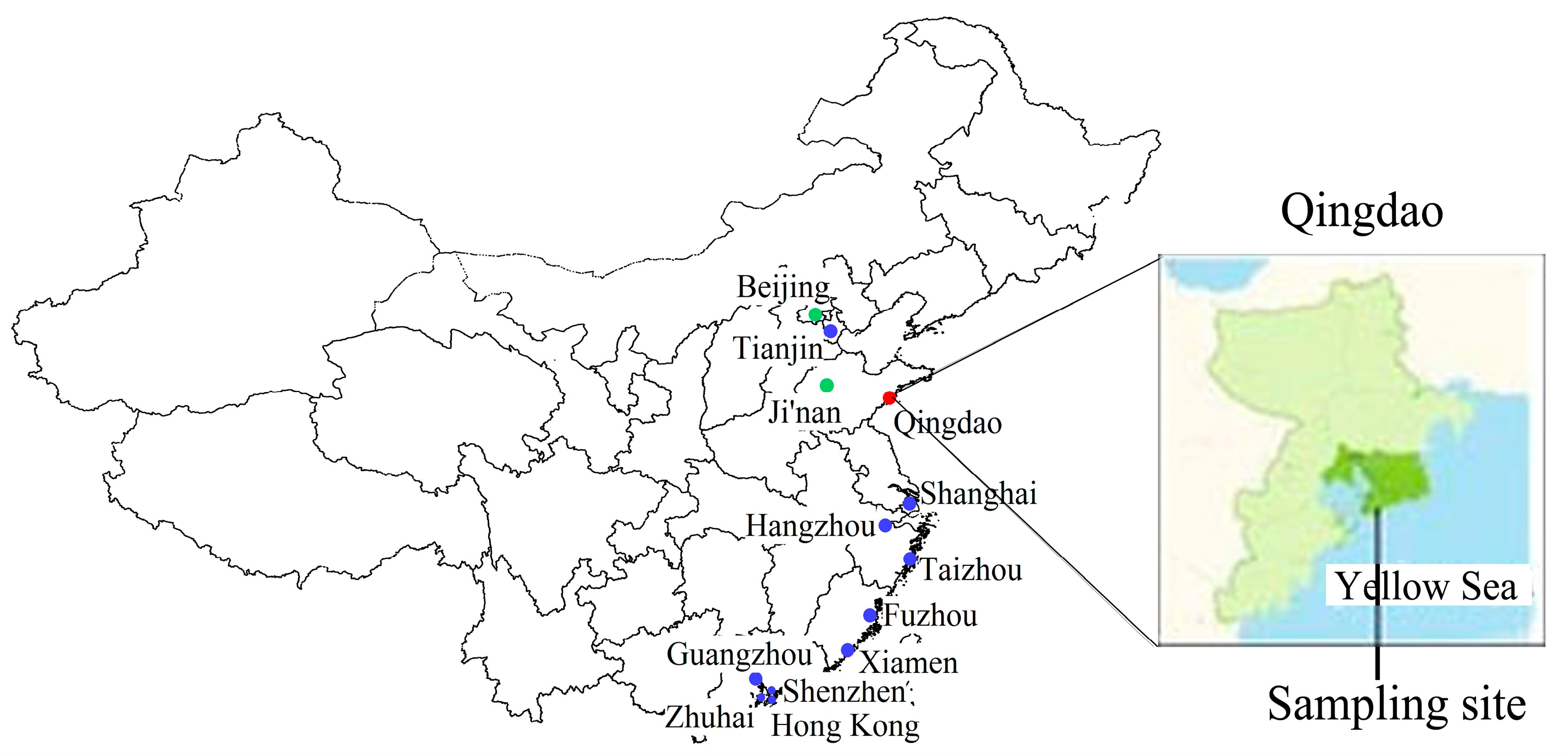

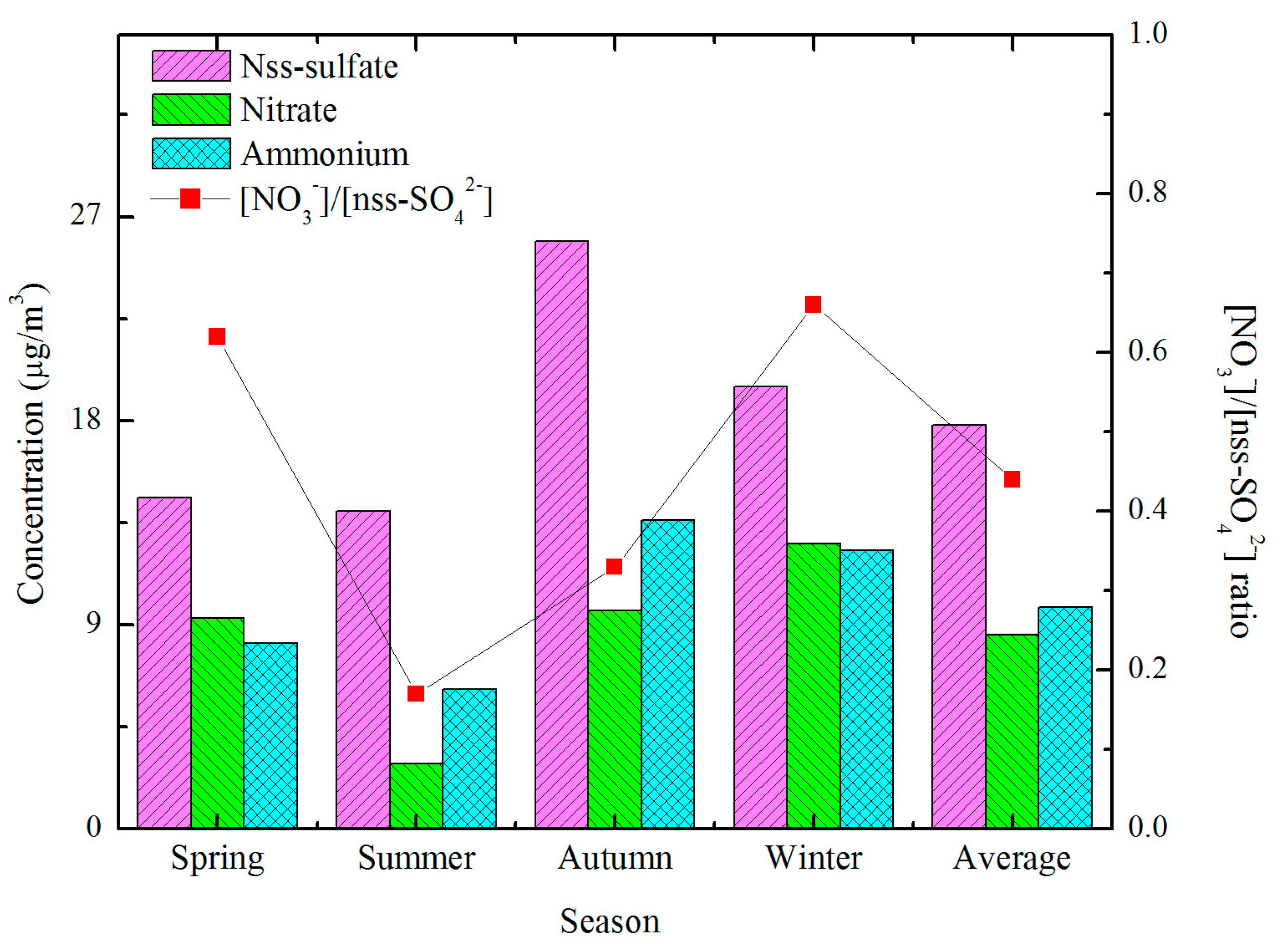
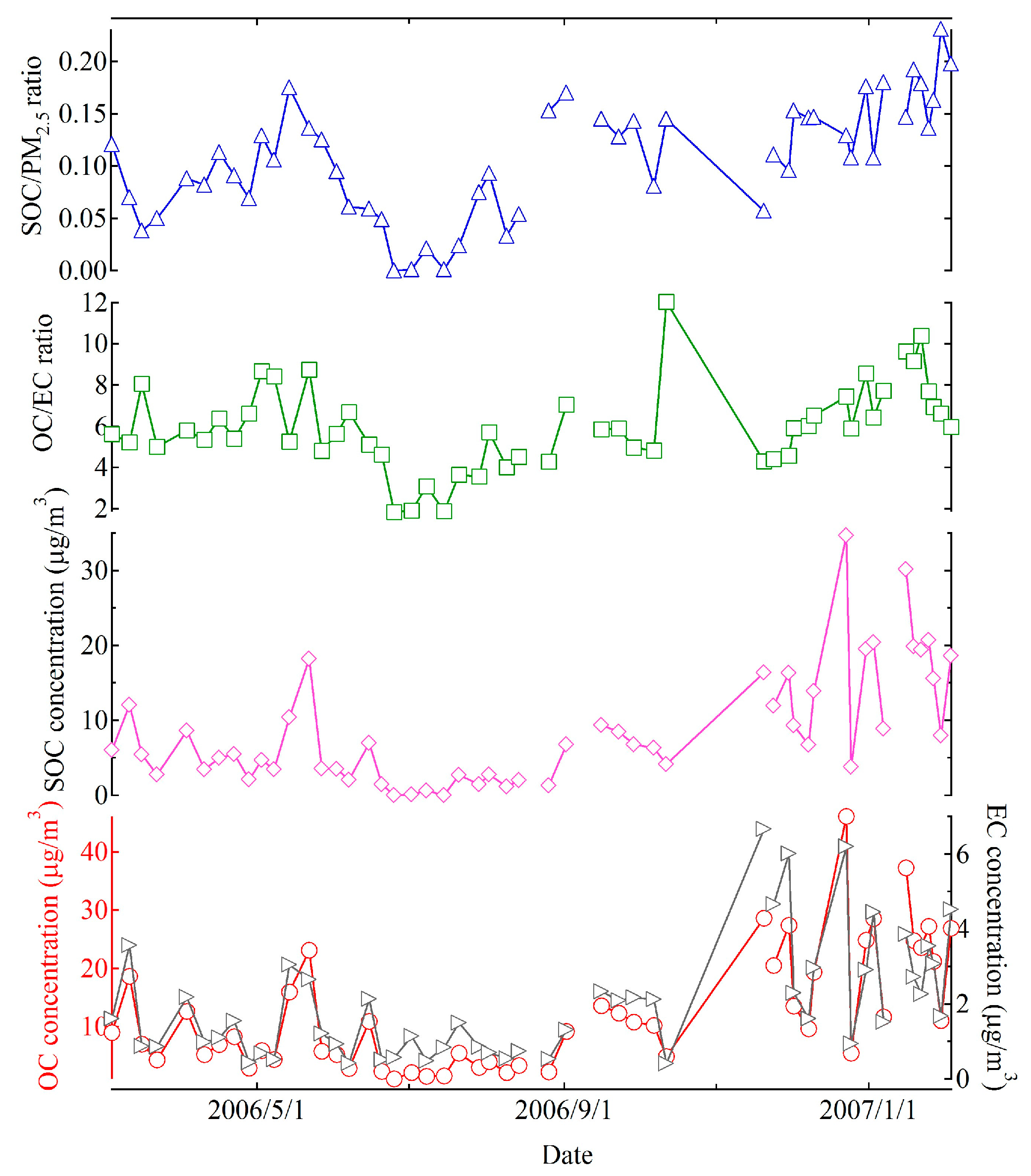

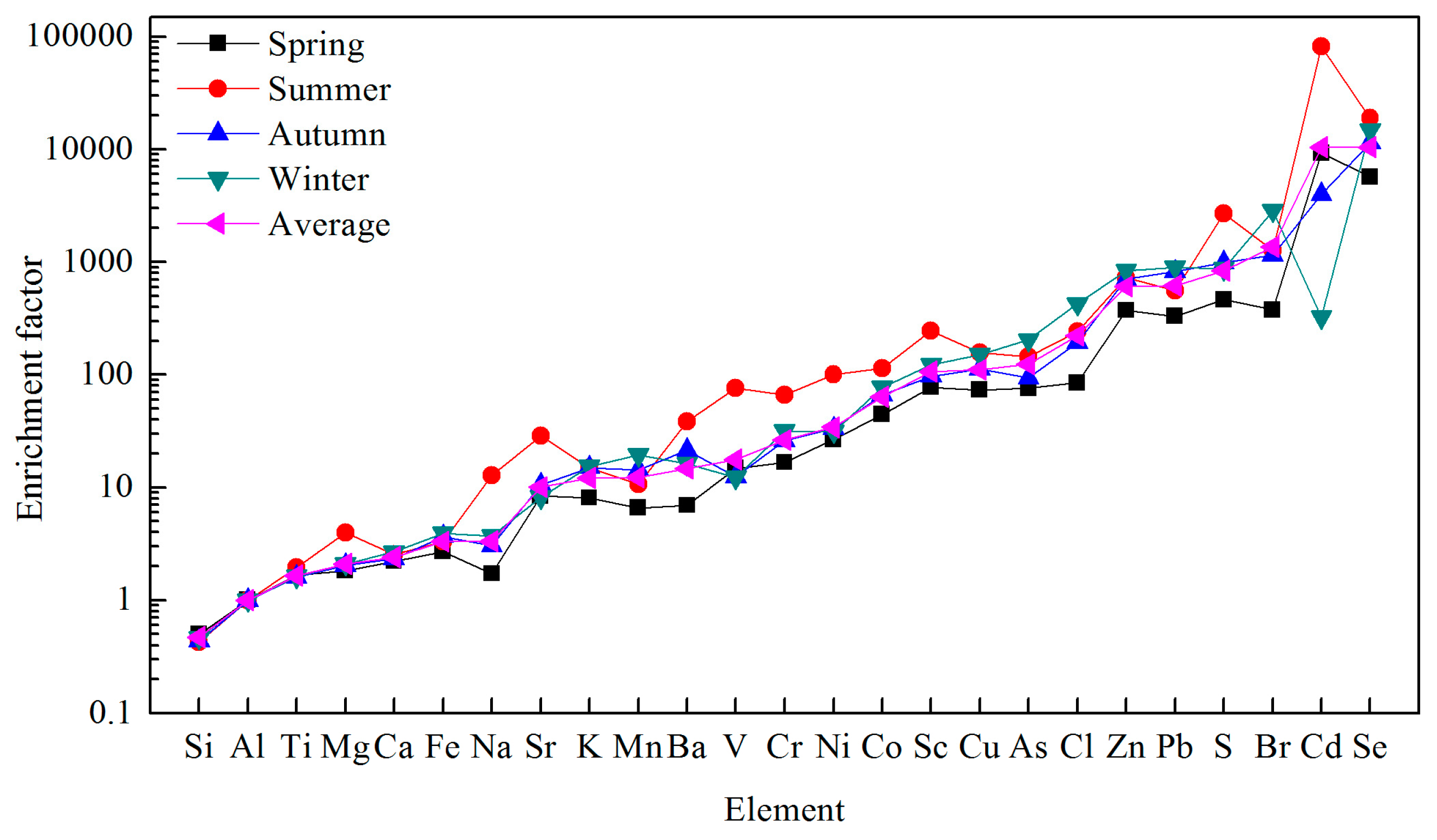
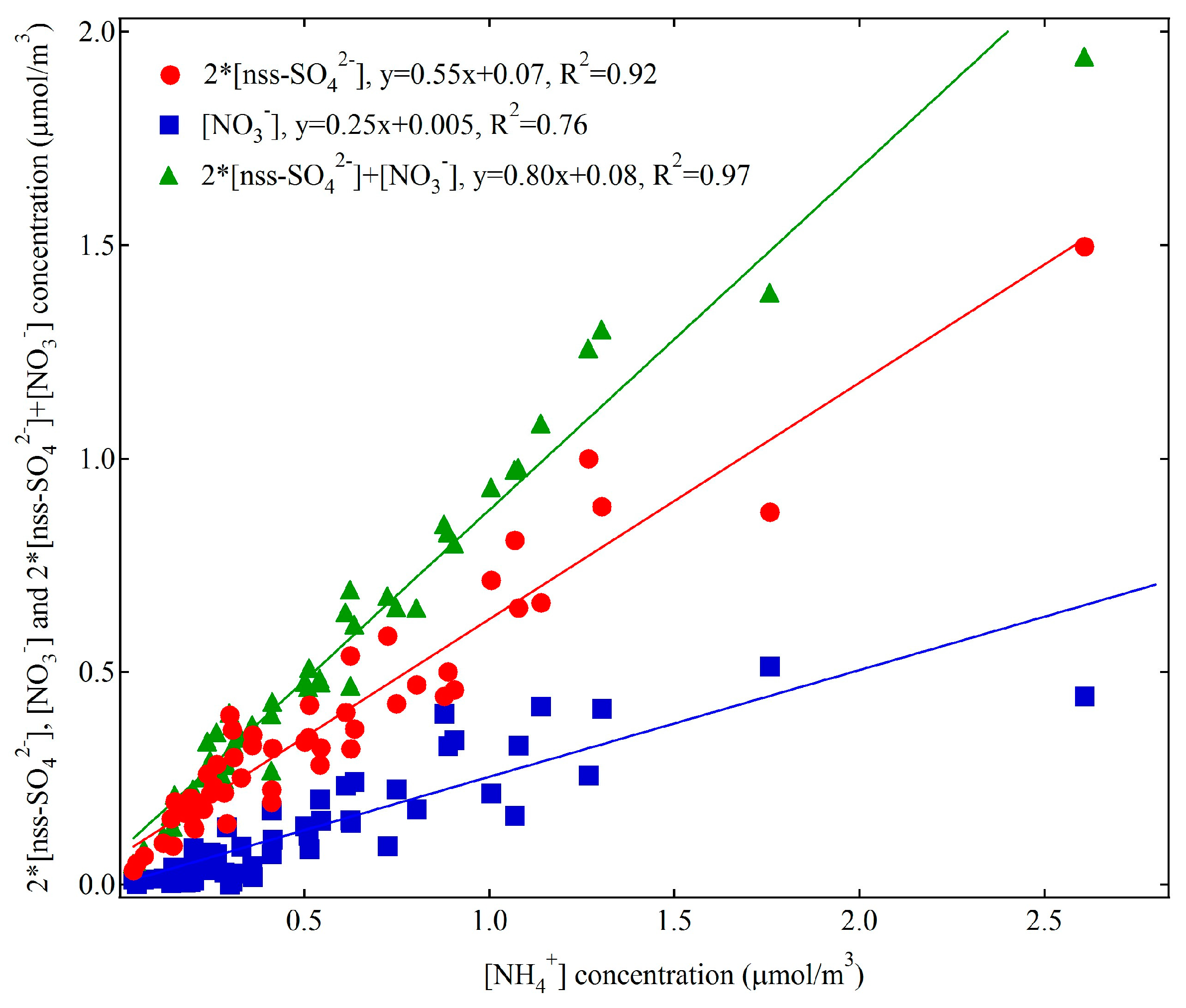
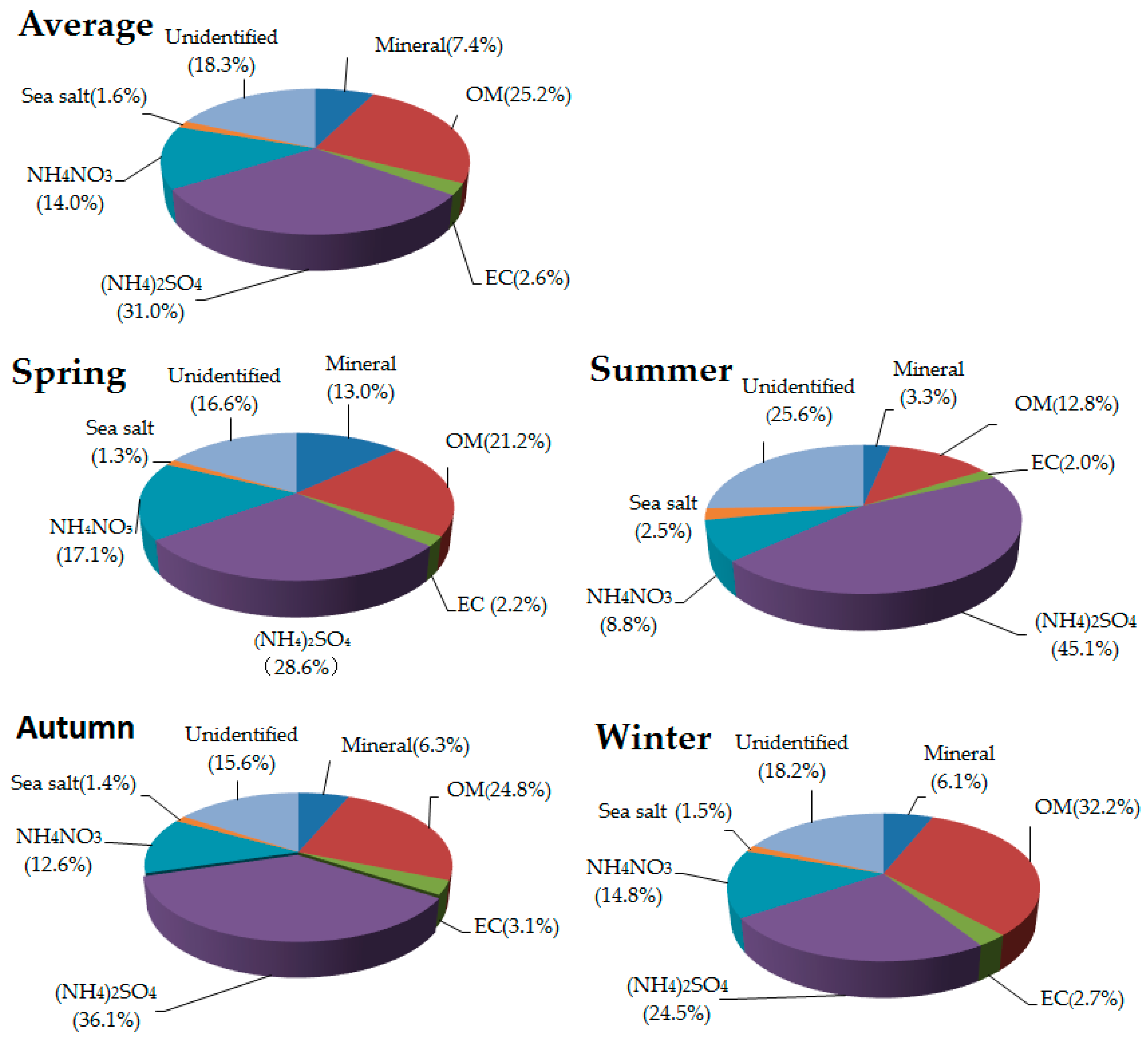


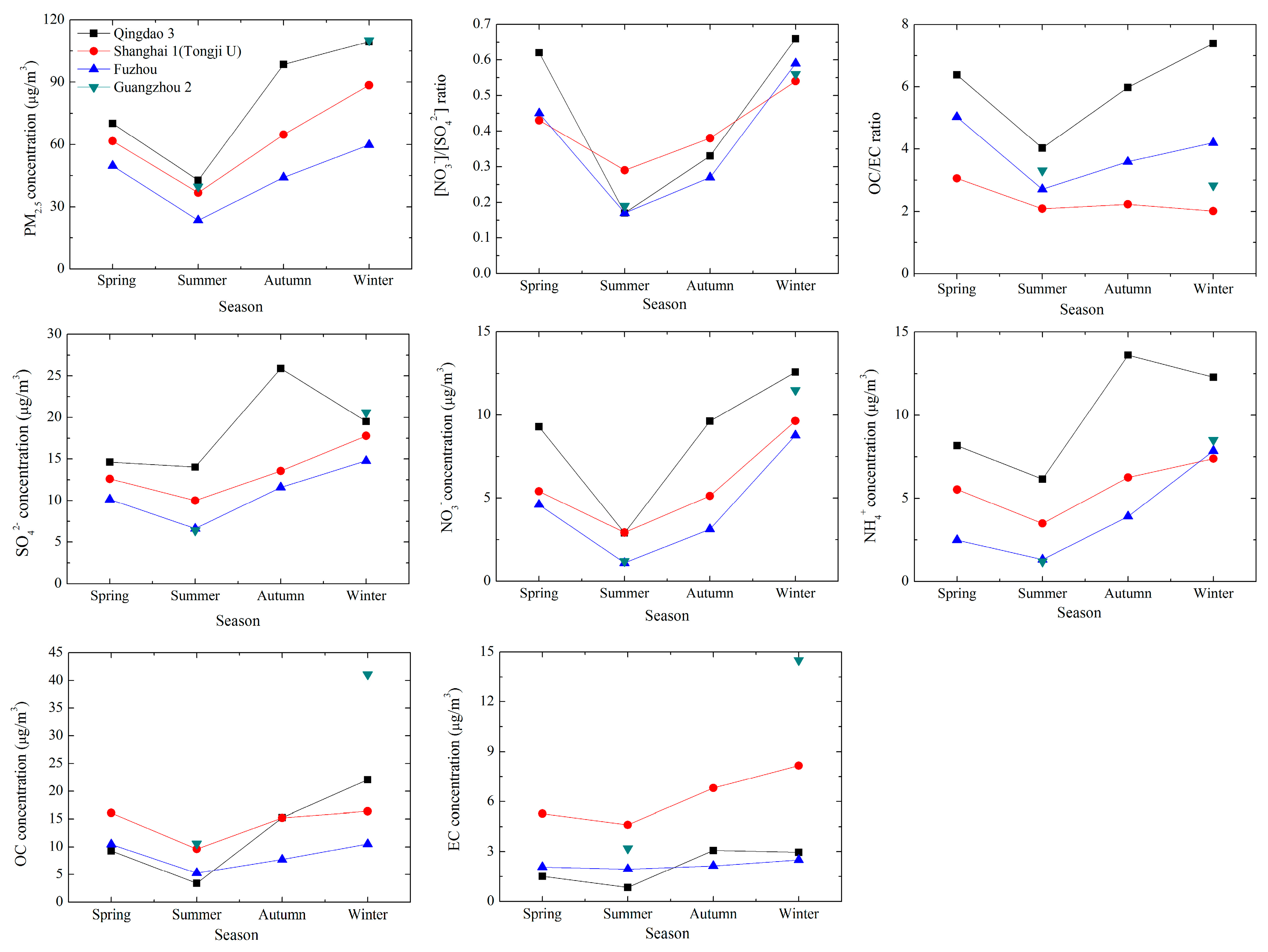
| PM2.5 and Species | Spring | Summer | Autumn | Winter | Average |
|---|---|---|---|---|---|
| PM2.5 | 70.1 | 42.8 | 98.6 | 110 | 79.0 |
| Acetic acid | 0.031 | 0.014 | 0.060 | 0.192 | 0.076 |
| Formic acid | 0.050 | 0.024 | 0.049 | 0.067 | 0.045 |
| Oxalic acid | 0.303 | 0.242 | 0.308 | 0.222 | 0.265 |
| Nitrate | 9.29 | 2.90 | 9.62 | 12.6 | 8.58 |
| Nss-sulfate | 14.6 | 14.0 | 25.9 | 19.5 | 17.8 |
| Chloride | 1.12 | 0.592 | 2.27 | 4.02 | 2.01 |
| Sodium | 0.361 | 0.423 | 0.544 | 0.632 | 0.488 |
| Ammonium | 8.17 | 6.16 | 13.6 | 12.3 | 9.76 |
| Potassium | 1.17 | 0.423 | 2.15 | 1.90 | 1.35 |
| Magnesium | 0.103 | 0.076 | 0.210 | 0.167 | 0.133 |
| Calcium | 0.511 | 0.153 | 0.533 | 0.532 | 0.425 |
| OC | 9.29 | 3.42 | 15.3 | 22.1 | 12.4 |
| EC | 1.52 | 0.848 | 3.08 | 2.96 | 2.02 |
| Al | 0.749 | 0.117 | 0.505 | 0.510 | 0.468 |
| Na | 0.299 | 0.347 | 0.356 | 0.441 | 0.363 |
| Cl | 0.956 | 0.427 | 1.48 | 3.28 | 1.57 |
| Mg | 0.164 | 0.056 | 0.124 | 0.130 | 0.118 |
| Si | 1.86 | 0.250 | 1.10 | 1.19 | 1.10 |
| S | 4.45 | 4.07 | 6.42 | 5.69 | 5.05 |
| K | 1.76 | 0.507 | 2.20 | 2.29 | 1.65 |
| Ca | 0.420 | 0.075 | 0.298 | 0.344 | 0.284 |
| Sc | 0.008 | 0.004 | 0.007 | 0.009 | 0.007 |
| Ti | 0.066 | 0.012 | 0.043 | 0.044 | 0.041 |
| V | 0.013 | 0.011 | 0.008 | 0.008 | 0.010 |
| Cr | 0.012 | 0.008 | 0.013 | 0.016 | 0.012 |
| Mn | 0.048 | 0.012 | 0.070 | 0.096 | 0.056 |
| Fe | 0.827 | 0.159 | 0.760 | 0.817 | 0.632 |
| Co | 0.007 | 0.003 | 0.007 | 0.008 | 0.006 |
| Ni | 0.008 | 0.005 | 0.007 | 0.006 | 0.006 |
| Cu | 0.020 | 0.007 | 0.020 | 0.028 | 0.019 |
| Zn | 0.268 | 0.081 | 0.342 | 0.409 | 0.271 |
| As | 0.008 | 0.002 | 0.007 | 0.015 | 0.008 |
| Se | 0.008 | 0.004 | 0.011 | 0.015 | 0.010 |
| Br | 0.022 | 0.012 | 0.047 | 0.117 | 0.051 |
| Sr | 0.016 | 0.009 | 0.014 | 0.011 | 0.012 |
| Cd | 0.009 | 0.012 | 0.003 | 0.000 | 0.006 |
| Ba | 0.039 | 0.034 | 0.082 | 0.062 | 0.052 |
| Pb | 0.109 | 0.029 | 0.185 | 0.204 | 0.128 |
| Item | Spring | Summer | Autumn | Winter | Average |
|---|---|---|---|---|---|
| Clexcess/Clreference | 0.69 | −0.29 | 0.53 | 2.24 | 0.85 |
© 2017 by the authors. Licensee MDPI, Basel, Switzerland. This article is an open access article distributed under the terms and conditions of the Creative Commons Attribution (CC BY) license (http://creativecommons.org/licenses/by/4.0/).
Share and Cite
Wu, R.; Zhou, X.; Wang, L.; Wang, Z.; Zhou, Y.; Zhang, J.; Wang, W. PM2.5 Characteristics in Qingdao and across Coastal Cities in China. Atmosphere 2017, 8, 77. https://doi.org/10.3390/atmos8040077
Wu R, Zhou X, Wang L, Wang Z, Zhou Y, Zhang J, Wang W. PM2.5 Characteristics in Qingdao and across Coastal Cities in China. Atmosphere. 2017; 8(4):77. https://doi.org/10.3390/atmos8040077
Chicago/Turabian StyleWu, Ruidong, Xuehua Zhou, Linpeng Wang, Zhe Wang, Yang Zhou, Jingzhu Zhang, and Wenxing Wang. 2017. "PM2.5 Characteristics in Qingdao and across Coastal Cities in China" Atmosphere 8, no. 4: 77. https://doi.org/10.3390/atmos8040077





